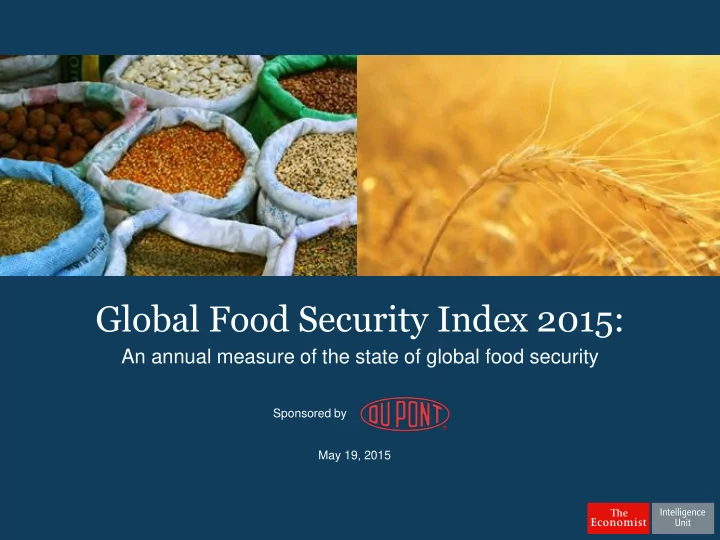

Global Food Security Index 2015: An annual measure of the state of global food security Sponsored by May 19, 2015
Agenda I. Introduction Overview & objectives Framework 2015 results II. Global Trends Geopolitical trends Commodity prices (food) The wheat story Population moves III. Global Results GFSI topline results Category stories Trends analysis IV. Insights Key lessons GFSI: A framework for action/priorities Innovations for food security
Introduction
Overview of the Global Food Security Index (GFSI) Indexing three core issues in 109 countries Affordability Availability Quality and Safety
Key objectives of the Global Food Security Index To create a quantitative approach to evaluating the dynamics of food systems and the ability of countries to feed their populations To identify factors that drive food security To determine country strengths, weaknesses and best practices To highlight areas of action, policy needs and other system gaps
GFSI indicator framework: 19 measures across 3 categories Food consumption as a share of household expenditure Sufficiency of supply (%) Public expenditure on agricultural R&D Proportion of population under global poverty line Agricultural infrastructure GDP per capita, $US, PPP Volatility of agricultural production Agricultural import tariffs Political stability risk Presence of food safety nets Corruption Access to finance for farmers Urban absorption capacity Food loss GFSI GFSI Index Index Diet diversification Food Price Adjustment Factor Nutritional standards FAO global food price index Micronutrient availability adjusted for income growth, Protein quality exchange rates and a pass- through coefficient of global to Food safety national food prices Applied to Affordability score Quarterly update to baseline model * Composite indicators are bolded.
Food security has improved globally The GFSI shows improvements across all categories of food security since the launch of the index in 2012 Global Food Security Index 2012-2015: 109-country average score changes, year-on-year 2012-2013 2013-2014 2014-2015 OVERALL +0.4 +1.1 +1.2 Affordability -0.3 +2.3 +1.0 Availability +1.2 +0.1 +1.4 Quality & Safety 0 +0.4 +1.1
2015 GFSI results Best Good Moderate Needs improvement
Global trends: The global outlook for food security
Geopolitical trends in 2015 Middle-income countries (MICs) now make up more than 5 out of the world’s 7 billion people Growth in non-OECD countries (including low and middle income) will slow down, from 4.5% in 2014 to 4.0% in 2015, but then is projected to increase to 4.7% in 2016 Political risks permeate the globe Territorial instability, religious extremism and humanitarian crises all impact global markets Eurozone stagnation continues to slow improvements in European food security
Falling food commodity prices …make food more affordable for all
Wheat: demand will outstrip supply Demand for wheat is projected to increase 60% by 2050 (m tonnes) Days
The population shift to cities continues 2014 by 2050 Urbanisation is putting strain on cities, where access to fresh, nutritious food is often limited.
Global results: How do countries perform across food security measures?
2015 GFSI topline results
2015 GFSI topline results : Areas of improvement
Affordability results 2015: Asia & Pacific region improves 75% of Asia & Pacific countries saw increases in GDP per capita, aiding access to food The percentage of people under the global poverty line in the region decreased – mainly due to improvements in Vietnam, China, India and Pakistan.
Availability results 2015: Central & South America Chronic food-aid dependency falls Half of the 18 countries in the region rely on ongoing assistance from the World Food Program Considerable strides have been made in decreasing reliance on this type of assistance over the past year Agricultural infrastructure inadequacies and relatively high corruption risk continue to constrain food security gains in the region
Quality & Safety results 2015: low-income countries advance Diet diversity and micronutrient availability biggest areas of improvement Diets are more diverse, and saw gains in this area over the past year, but still the most reliant on starchy foods Protein quality improvements seen in a number of countries Low-income countries continue to register low availability of micronutrients – vitamin A and some types of iron- in the food supply.
GFSI trends analysis: Four years of insights
Trends analysis: 2012-2015
What have we learned?
The GFSI: a framework for priorities and action • Governments use the index as a policy check • A country diagnostic tool for investment • A number of countries have asked to be included in the Public benchmarking index sector • Use the index to determine key countries to focus their advocacy efforts for food security policy changes Non-profits • Use the index as an active research tool and NGOs • Uses the index as a launch pad to explore food consumption and CSR initiatives Private sector
Innovations for food security: Doing more with less Food-security issues +2015: Food-security challenges Climate change Soil depletion and degradation Climate Water access Change Soil Possible yield plateaus depletion Decrease Addressing rapid population growth in yield Applying science to solve problems Financing tools for smallholders Urban agriculture Innovations
Contact information Dedicated microsite Please visit: http://foodsecurityindex.eiu.com Thank you
Recommend
More recommend